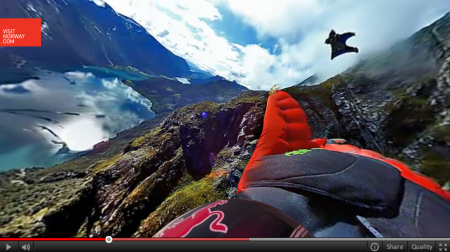» Next Entries
Category
Marketing
-
Marketing, Travel & Tourism
Vacation rentals are an opportunity for DMOs
12.04.12 | Permalink | 2 CommentsLast week I was presenting at Travelnext in Utrecht, the Netherlands. One of the speakers was Ole Ruch from AirBnB. He shared some info that made me think.
Economic benefits
I thought that most AirBnB users were looking for cheap accommodations. They’re not.

Some (AirBnB funded) research in San Francisco concludes that AirBnB customers spend more money in destination. And the money (minus a commission) goes directly to the host.

The econonomic benefits are also distributed throughout the destination.
Primary reason for travel

People live in incredible places or have done amazing things with spaces. And through AirBnB travellers can now access them. You can stay
- in a house designed by Frank Lloyd Wright
- in hobbit house in Montana
- in one of fourteen private islands
- in one of seven available iglos
- a houseboat next to the Eiffel Tower
- a villa in Tuscany
- and many more unique places
You get my drift. There are some incredible private places for rent and people will travel just to stay there. Consumers are also shifting and are looking for unique and authentic experiences. Staying in a local neighbourhood or in somebody’s house is meeting that need.
I’ve never seen a DMO promote an AirBnB listing (or one of their competitors). Not even a very unique one. Don’t they take it seriously because it’s unconventional, because it’s a disruptor of their funding model or because hotel stakeholders are seeing it as a threat? Either way, the economic benefits are there and I think it’s a powerful tool in the toolbox that shouldn’t be ignored.
-
Experience Design, Marketing, Travel & Tourism
Cascading influence in tourism marketing
05.16.12 | Permalink | 4 Comments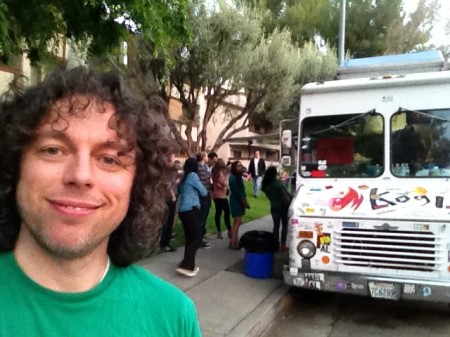
I’m not a foodie. But I like food. I like cooking. I like to eat good food. I like authentic experiences. I like holes in the wall. I once drove 5 hours to eat deep fried cheese. And when I was in LA last month I drove an hour to visit the Kogi food truck (photo). But I don’t really watch food shows, read food blogs or base every restaurant I visit on reviews on Yelp or Tripadvisor.
I have friends for that.
My friend Stephanie is a foodie. She tries crazy recipes and knows about all the new and hot restaurants in town. And beyond. There aren’t a lot of cities I travel to where she doesn’t know of someplace amazing.
Stephanie is not a big food influencer. She doesn’t blog, doesn’t take photos of her food, she doesn’t pin food recipes. She does influence her friends though. In person or on Facebook. And if she recommends a restaurant, I’m going.
I’m not a foodie. But I’m influenced by one.
Stephanie in turn, is influenced by a host of people who share her obsession with food. She’s part of a passionate community of foodies. A lot of her friends are foodies, she watches Food TV, reads a lot of food blogs, is active on Chow and follows celebrity chefs on Twitter.
Stephanie is a foodie. She makes her decisions based on information from influencers in the foodie community.
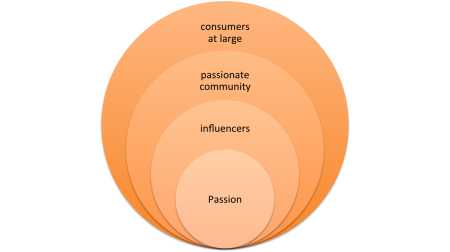
The example above is the essence of modern tourism marketing. Restaurants will get people like me in the door because I’m influenced by a foodie, who in turn is influenced by leaders in the foodie community.
As a marketer, you need to approach this in reverse. Activate the influencers who connect with the passionate community, who in turn connect with consumers at large.
This works for any kind of niche. Hiking, skiing, modern art, theatre, gambling, roller coasters, etc. There are thousands of passionate communities and each community, large or small, has influencers. It’s just a matter of activating it.
As a tourism marketer you need to identify your niches and ensure the delivery of your experience is remarkable so people will recommend your destination or product. It will start a cascading effect that produces long term results.
-
Management, Marketing, social media, Travel & Tourism
5 levels of social media sophistication at the DMO
04.23.12 | Permalink | 34 Comments
Imagine you had to start a DMO. Your DMO. You have been given the same budget and must start from scratch. Would your DMO look exactly the same as it does now? The same departments, same positions? The same budget allocations? The same marketing tactics?
The internet, and social media in particular, have completely changed tourism marketing. Forever. People might not talk on Facebook about which fabric softener they use or which soft drink they prefer, but everybody talks about their travels. Social media sophistication is crucial to modern marketing. Yet the tourism industry is way behind.
We have worked with dozens of DMOs around the world, ranging from very small to very large. And we have spoken to hundreds more. Based on our conversations and experiences we have identified the following levels for social media adoption and integration into the organization.
1) Ignoring social media
This level represents DMOs who are not active at all in social media. Social media is seen more as a threat than an opportunity.Characteristics you can find at this level are:
- Leadership that is very skeptical of social media (“Facebook is a waste of time,” “I don’t care what my old high school buddy had for dinner last night,” “Twitter is for young people,” etc.)
- Fear of negativity
- Restricted staff access to social networking sites through policies or technology
- Lack of an internal social media champion
- Lack of social media knowledge at marketing agencies
- Traditional marketing methods
- No budget for social media
Two years ago, there were many DMOs at this level, but by today most have moved on. Most DMOs that remain here are tied to very restrictive government policies.
2) Experimenting with social media
DMOs experiment with social media without a specific strategy through random tactics.Characteristics you can find at this level are:
- Leadership that is skeptical, does not know activities are happening, ignores them because of disinterest, allows it because an influential stakeholder asked questions, or is swamped dealing with politics
- Fear of negativity and overreaction when something “bad” happens
- Enthusiastic internal champions who have created rogue accounts but sometimes lack skills to properly execute. These people eventually leave the organization to properly grow their skills elsewhere
- Hit or miss results
- Chasing anything that is new and hot
- Lack of social media knowledge at marketing agencies
- No or very little budget
- No metrics
There are still a lot of DMOs operating at this level. It often takes a noticeable event to move them to the next level. This could be spurred by a social media success internally or by the DMO next door. For example, a rival’s viral YouTube video or growing number of Facebook fans.
3) Social media supporting marketing campaigns
Due to a lack of strategic knowledge, DMOs incorporate social media in paid, outbound marketing campaigns. Often this is an add-on to traditional marketing campaigns, such as a YouTube channel showing videos originally made for TV or using Facebook and Twitter to broadcast campaign messaging.Characteristics you can find at this level are:
- Leadership that realizes social media can be powerful but still relies/insists on traditional methods because they are more comfortable with them, or do not know how to measure and compare the difference in results
- Marketing agencies that reluctantly incorporate social into campaign strategies, often as an afterthought and/or without understanding social media principles
- Little integration or collaboration with members/partners/industry
- Heavy scheduling and approval processes for social media activity
- Broadcast-style communication in social media
- Viewing and communicating with fans and followers in a traditional outbound marketing way, such as a consumer email database
- Year-round efforts on Twitter, Facebook, etc., that lack strategic direction
- Social media black-outs when there is no campaign in market
- Frustrated and/or maxed-out staff who understand the potential of social media but are not heard by leadership and sometimes need/want more training
- Often staff skilled in social media leave the organization out of frustration
- Budget that is a small portion of marketing campaigns
- Lack of appropriate metrics, with success often measured either by big numbers (# of fans/followers) or a campaign’s level of creativity
Most DMOs operate at this level, sometimes with some additional effort to keep Facebook and Twitter going year-round. Often the level of success depends on the sophistication of one or two staff members.
DMOs at this level want to succeed but cannot break out of the traditional way of doing business. Getting to level four is usually achieved by having a strong social media success as part of a bigger initiative or having an epiphany that social requires a different way of thinking. Usually, level two experiments continue alongside level three activity.
4) Following a social media strategy
This level is typified by a DMO having a social media strategy in place or having social media integrated into its marketing strategy. The DMO still believes that it is in full control of the destination brand.Characteristics you can find at this level are:
- Leadership that understands social media and has given it dedicated resources
- Marketing campaigns that have social at the core
- Agencies in place that are dedicated to social or a digital agency that (really) gets social
- Social strategies in place tied to marketing goals and objectives
- Stronger alignment/integration with members/partners/industry and other stakeholders
- A move from mass to niche marketing
- Activities that are measured and adjusted in real time
- Staff that is trained in social media
- Empowered staff that is allowed and encouraged to participate as a DMO professional in social networks
- Social media monitoring and engagement that is in collaboration with members/partners/industry
- Social media that is incorporated in customer service
- Relaxed social media access policies and limited approvals for posting content
- Crisis plan in place
- Systematic experimentation that is part of the strategy
- Dedicated staff and budget for social media
Leading DMOs have entered this level. Over the next few years we expect a rush of DMOs moving here. DMOs that enter level four first are the ones with less restraining operating environments (such as funding) with innovative leaders and marketing managers.
5) Embracing the social business model
The level five social business recognizes that the destination’s story and reputation are based on visitors’ experiences at every touch point during their trips (see point 1 in “Top 5 Wrong Assumptions in Destination Marketing”). This DMO knows and accepts that it is no longer in control of the destination story. It recognizes and acts on the need to collaborate closely with its industry, residents, influencers and visitors, and that it must change the way success is measured.
The level five DMO starts with the core of the passions that make a destination relevant and leads all partners that have an impact on those experiences. The sole focus is on delivering outstanding visitor experiences that are unique to the destination, and then making it easy for visitors to share these experiences in their own voices.
As painful as it may be, the DMO re-organizes, ending much of its old way of doing business. Staff is re-trained and assigned to new activities.
Characteristics you can find at this level are:
- Leadership that understands that business models from 15 years ago must change and is willing to undertake the pain of changing the organization
- Relentless focus on the consumer
- Majority of marketing resources are allocated to digital
- A shift from destination marketing to destination management, where the customer experience is seen as the primary way to build brand
- Marketing strategies that are a collaborative effort between the DMO, industry, residents, passionate consumers and other stakeholders
- A move from mass marketing to niche marketing
- Culture of collaboration, internally as well as with members/partners/industry and even consumers
- Flattened organizational hierarchy to increase efficiency and speed needed to respond and adjust quickly
- Lean processes
- Staff that is trained, empowered and supported to make decisions without requiring lengthy approvals or spending time in meetings designed by management to control every aspect of every tactic
We’re not aware of any DMOs at level five. We have spoken to many DMO executives who know they need to get here and want to get here. Often, their funding models or destination-specific politics stand in the way.
The DMO closest to a level five we are familiar with is Visit Sørlandet in Southern Norway. As a newly created regional DMO, this organization quickly realized it would be impossible to build a Southern Norway brand the traditional way. By creating a strategy based on collaborating with local DMOs and industry members to improve the visitor experience and elevate the collective digital marketing efforts, Visit Sørlandet is building it’s brand through every touchpoint while growing repeat visitation and encouraging word-of-mouth.
For many DMOs that have not reached level four, level five may seem pie in the sky. But the further you move your DMO through the levels, the more you realize just how much the world has changed and the true impact this has. Once you enter level four, you can see level five. It is no longer pie in the sky. It is tomorrow.
At what level is your DMO?
Your DMO’s current level is not a sign of success or failure. Every DMO is different. Politics and funding models have a big impact. So does the size and scope of a DMO. A country DMO is different from a city DMO. This affects specific marketing strategies and tactics.It is also not a race. It is a process that organizations need to go through. Some might skip a step. For others, the levels could overlap. But in order for DMOs to stay relevant and effective, they need to climb up.
We have worked with DMOs in all shapes and sizes at every level of this process. We enjoy helping DMOs make the climb.
We have conducted audits, started Facebook pages, trained staff, implemented social media as part of bigger campaigns, run social campaigns, created strategies, helped to define entire business plans centered around social principles and much more.
Inventing the future
Alan Kay, the inventor of the GUI and object-oriented programming once said, “The best way to predict the future is to invent it.” Instead of all DMOs trying to invent level 5 independently, we think the best future is that we all invent it together and collectively stay relevant. Please share your thoughts in the comments.As always, thanks for all my Think! coworkers for their contributions in creating this post
-
Internet, Marketing, Travel & Tourism
Making conferences social

Conferences are inherently social. People gather to learn and discuss topics that they are passionate about with people who care as much about it as they do. Yet the way conferences are created and promoted are incredibly traditional.
There’s a better way: bake social into the conference.
A good example is the Social Media Tourism Symposium Think!’s very own Dave Serino started in 2010. The mission statement describes what the conference is all about:
The symposium is a combination of destination marketing organizations, hotels, resorts, attractions and any other tourism related entities sharing ideas and learning more about how social media is effecting promotion within the travel industry.
What makes this conference unique is the involvement of attendees throughout the entire process. Attendees will have a voice in everything from the location to the session topics and presenters.
By involving the people who care about the subject matter in the planning process, Dave creates a conference that is more relevant and, therefore, more likely to be attended by the people who helped create it. Because all of this happens in social media, people who care are also promoters of the event.
For example, the destination selection process is driven by the SoMeT Facebook community. DMOs respond to an RFP and the Facebook community votes where the conference is going to be held. The 2012 selection process is entering the final stages.
In the process, people also get to know each other. They make friends online and want to attend the conference to meet those new friends.
This is what conferences are all about. Going to a cool place, learning relevant things and meeting new friends. By baking social media into the conference itself (instead of looking at it as an advertising vehicle) you make conferences more relevant with attendees who feel strongly connected and want to help make the event a success.
-
Internet, Marketing, Travel & Tourism
Remarkable content instead of advertising
At Think! we believe consumers will do the marketing for you if you offer remarkable things. One way to generate awareness and consideration is by creating remarkable content that’s relevant to a specific niche. In Norway they have the concept down to perfection.
Visit Olso created an advergame in collaboration with Innovation Norway that’s played millions of times. I interviewed Katrine Mosfjeld about it a couple of years.
Innovation Norway’s gorgeous Geiranger birds-eye panorama view has generated over half a million visitors to their website through Stumbleupon alone. StumbleUpon is a community that recommends remarkable content with each other.
Innovation Norway has been at it again. This time with an amazing panorama video of a wingsuit flight. According to a recent blog post, the video has been viewed over 1 million times in just under one month. What’s also notable is that Red Bull shared the video on their Fanpage of 25M fans. For a Red Bull fan, a wing suit flight is relevant content and it was liked 2,350 times and re-shared 651 times. This is earned media in 2012.
Generating awareness doesn’t have to come through advertising. Norway is showing that producing remarkable content will get shared in the right social media communities.
-
Internet, leadership, Management, Marketing, Travel & Tourism
Top 5 Wrong Assumptions in Destination Marketing
01.09.12 | Permalink | 69 Comments1) Building a destination brand through advertising

You can’t. A destination brand is:
- The sum of experiences of a traveler during a trip (but not all experiences are equal)
- The sum of all stories somebody has hears about a destination (but not all sources are equally credible)
Ten years ago, your TV ads, brochures and other forms of marketing collateral contributed a sizeable portion of the stories people heard about a destination. Not anymore. People telling other people, aided by new forms of communication (including social media but not exclusively) is now dominant and has make brand advertising hopelessly inefficient.
Ensuring your destination has quality experiences, getting your operators up-to-speed in modern marketing and actively managing your destination’s reputation in social media, especially in niche communities is how you build and manage a destination brand.
2) People still like paper guides/call centers/newspapers/magazines/consumer shows/travel agents/etc.
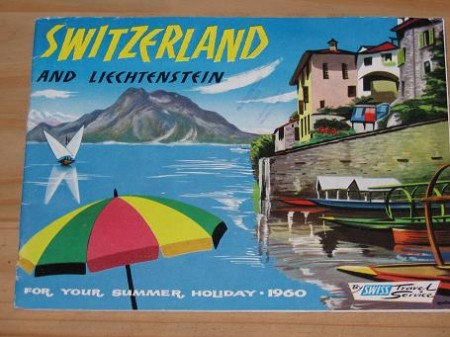
Yes they do. But is it the most effective way for you to get your stories told?
I get it. It used to be so succesfull. You’re still proud of the results from 1998. And it’s really hard to stop doing something. Staff will be effected and change management in an organization is often messy.
But lets get real. Most people have moved on. The biggest bang for your buck lays elsewhere and we both know it.
Stop making excuses, take close and hard look at your activities (budget + people) and stop doing the things that have become inefficient or ineffective.
3) Operating a reservation system will generate extra revenue

It probably won’t. And if it does, it’s going to take a lot of hard work against stiff competition.
I know it’s tempting. There’s the potential for extra revenue and your hotels are putting on the pressure to fill their rooms now instead of focussing on the long term. It’s also something tangible to measure and the technology is so easy now. And cheap.
But consumers just don’t think of a DMO website as a place to transact. They have a gazillion options to book. And usually at a much better rate than the DMO will ever be able to offer.
Making a booking system produce results is hard work.
When you choose to operate your own reservation system where your accommodation operators give you specific rates and inventory, you also need people to manage this process. That means chasing operators for rates and inventory, sending out commission cheques, chasing operators for money and dealing with customer service issues.
You’ll also need people who stay on top of your website and the conversion funnels. What advertising drives bookings? Where do people drop off in the funnel? What do you need to tweak to increase your conversion rate?
I’m not saying offering bookings is a bad idea, especially not if you’re a city DMO. An aggregator like JackRabbit is a good option add booking capabilities to your website without the operational overhead for example.
An even better option is if you have a way to differentiate yourself from online travel agents by creating value added packages online travel agents can’t offer and target these to niche audiences.
4) Processes and organizational structures from the 90’s still work today

They don’t. The workplace of the 90’s was very much a leftover from the industrial age.
Let’s see what has changed over the last 15 years. Technology and the internet has turned travel planning and booking up-side-down. Everybody knows this, but most DMO’s just added some form of online unit or department in their structure and left it at that.
And there is more! Technology has also completely changed the way people work with new productivity and collaboration tools. Technology is becoming ubiquitous. Cloud computing allows you to outsource pretty much everything and access your data from anywhere. People stay connected through mobile devices and take work home on their laptops while Social Media has completely blurred the line between professional and private life.
The industrial age is over. All of the above has completely changed the way new generations think about the workplace. Corporate structures, hours of work, roles and responsibilities, staff retention all has to be re-thought. Just read Don Tapscott and Charlene Li.
5) The one stop agency of record is still effective

It usually isn’t. More and more DMO’s are challenged with their agencies of record based on what I hear at conferences.
From my perspective, the reason why most traditional agencies are still having a hard time with digital and are often completely clueless about social is because their culture and business model is based on traditional advertising principles.
In traditional advertising, you only have one shot at getting it right. You buy the media, produce the communication pieces and let it ride. An outcome of that is getting the creative right the first time is really important. As a result, right brain creatives run traditional agencies.
In digital marketing, the creative is still important but you should spent more time after launch by looking at the data, and keep iterating the tactics to keep perfecting it. Data and real-time analysis is part of a digital agencies culture. That’s a fundamental difference.
In social media, on top of digital marketing principles, you also need to humanize the message and open up your brand for consumer input. That’s often just too much to ask.
The result is that in most cases, DMO’s need to go best-of-breed and hire multiple, specialized agencies and contractors. With the new collaboration tools, it’s much easier to manage these days. We experience this with the increased number of RFPs out there specific to social media. Maybe a new ‘agency of record’ model will emerge at some point but that will take some time.
A one-stop-shop is definitely easier to manage on an executive level. Only one RFP to run, it simplifies managing the relationship (only one person to have lunch with or yell at) and streamlines back-office accounting processes. If you still want to go one-stop-shop, look for a digital agency that also does traditional instead of a traditional agency that also does digital.
Note: I understand that especially the first and last point on this list can be perceived as a pitch for my company. The reality is that this is exactly why I joined Think! in the first place. To help DMOs innovate and break through some of the conventional wisdom out there.
-
Marketing, Travel & Tourism
Leftover printed guides
01.01.12 | Permalink | 3 CommentsHappy new year. All the best for 2012. My resolution is ar least one post a week. We start with a tip.
Most DMO’s will have stockpiles of leftover printed guides from 2011 somewhere in a warehouse. Refusing to accept these are remnants of a distance past, they print more than there is demand.
Here’s an idea. Search for doctors and dentist offices in your key markets and send them a free copy. The combination of bored people waiting for their appointment with the low turnover of magazines in these offices will provide some good reach for relative low investment.
-
Marketing, social media, Think! Social Media, Travel & Tourism
Tap into people’s passion
A contestant for a contest we’re running for the Powder Highway tattooed “ski bum” on his butt in the hopes to win (see full video).

At Think! we believe marketing should be relevant and add value to people’s lives. We believe in tapping into the passions of niche audiences by offering remarkable experiences relevant to that niche.
When you tap into people’s passion, distance and money means a lot less. People will drive 5 hours to eat some cheeseballs if it means something to them.
We use this concept when we create marketing campaigns as well. For the Powder Highway contest, the price is very remarkable to people passionate about skiing and snowboarding
- Season’s passes at 8 ski resorts
- 4 days of heli skiing
- 8 days of snow cat skiing
- 3 months of accommodation
- a rental vehicle
- $500 worth of gas
Remarkable enough to get yourself tattooed. -
leadership, Marketing, social media, Travel & Tourism
I’ve seen the future of travel media
08.30.11 | Permalink | 13 Comments
Steve Keenan, online travel editor from the London Sunday Times summarizes Valencia’s unique approach to a media/blogging famValencia Leads
A few weeks ago the Valencia Tourism Region hosted a blog trip (#blogtripF1) and it could very well be the new standard for DMOs to model their traditional media trips or media fams after. I was fortunate enough to be invited on the trip.
Valencia Tourism invited a mix of traditional journalist, travel bloggers, social media travel, web technology and web design professionals. These people of all ages, with diverse skill-sets and interests where hosted on a four day event centred around Valencia and the Formula One Grand Prix.
It included all the hallmarks of a traditional media trip. Visits to the best restaurants, the top sights, attractions and accommodations. The trip included private guides and behind the scenes tours, all well organized as you can expect from any respectable DMO.
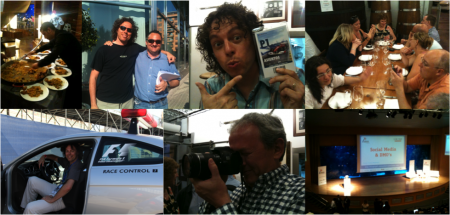
Making the media trip social
Valencia Tourism innovated the traditional trip by creating a place for these professionals to collaborate, discuss, debate and most of all develop new relationships. Social Media professionals are social by definition and unlike traditional journalists who are more driven by exclusivity, bloggers understand their individual success is strengthened by the success of their relationships and their network.Taking advantage of educational opportunities
The place to kick-off the discussion was at a conference where attendees presented a topic related to their area of expertise (videos of presentations here). The event was attended by many local, national DMO’s and operators. A great way to get Tourism Valencia’s stakeholders access to the knowledge in the group.Fostering the creation of networks
Over the next few days we got to know each other very well. There was enough time and opportunity to do so. We discussed and debated all topics digital travel professionals are interested in. And everything was tweeted in real time of course, creating a surge of Valencia exposure in real time, across many people’s personal and professional networks.
Creating remarkable experiences
Remarkable experiences turn into social objects, shared in social media. These are the things worth blogging, tweeting and Facebooking about. There were plenty in Valencia. Walking on top of a shark tank, eating the best Paella, incredibly photogenic modern architecture, random bars, more great food and of course the F1 race.Remarkable experiences was also the subject of my presentation, summarized in this interview
Build in surprises
Exclusive access, or including things money can’t buy will generate even more conversations. The trip offered personalized surprises such as a visit to the F1 paddock, a ride down the track in the safety car and even a drive in a converted 3-seater Formula One car for some.Results
The tally so far? By the last count I’ve heard a while back a few dozen blog posts have been written, 61 YouTube videos created, 363 people tweeted 1,558 tweets reaching over 2 million people all around the world while articles in traditional media are being written.But the real value is not just the immediate exposure but the fact that Valencia sits at the centre of a strong network of travel bloggers and tourism professionals including their expended networks. Valencia will always be top op mind when I connect with any of the new friends I’ve made.
Promoting by focussing on building networks and putting yourself in the middle of it. That’s the future. Valencia has re-invented itself over the last years with new tourism attractions, infrastructure and mega-events. They’re doing the same with destination marketing.
Congratulations Joantxo and Arantxa, you’re setting the new standard for travel media.

Valencia’s City of Arts and Sciences – Photo by Sherry Ott -
Internet, leadership, Marketing
Lessons for marketers from Googles search team
Every year Google launches over 500 improvements to its search algorithm. There’s a lot to learn from this video for modern day marketers.
Focus on your end user
It all starts with a focus on the user. “Google has made a huge investment in understanding what works for users (3:25)” because “when you align Google’s interests with user interests, good things happen (3:17)“.Aligning business objectives with user objectives should sit at the core of any online marketer principles. Without it, you’re sure to fail.
Keep improving what you have
Google is obsessed with improving their search product; “we get excited when we hit on an idea what helps a lot of users (3:37)“. Continuous improvements sits at the heart of their culture.Traditional marketers spend almost all their efforts before they launch because it’s hard to change things after. Online marketers need to spend the majority of their effort post launch. You receive instant results and it’s easy to change things.
This includes websites, social media, search, email marketing, etc.
Base decisions on data, not opinion
In too many organization, decisions are made based on opinions. Usually a senior person doesn’t like something or receives pressure from a stakeholder with an agenda and want something changed. Or a real problem is being dismissed because it’s invisible (a technology upgrade for example). Rarely does anybody actually look at the data in detail.At Google, “a problem identified and hypothesis created (0:35)” and subjected to “rigorous scientific testing (0:53)“, using a trained panel called raters (0:59), live experiments (1:14) and analyzed by a search analyst (1:14). The decission to make the change is then held in a “launch decision meeting (1:47) by the leadership, based on data with an unbiased view”.
Implementing this at your organization
These are some key elements of Google’s success. But even when you’re not Google with a large team, here’s what even the smallest organization can do:
- Always put the user first. Not your manager, not the CEO, not the creative genius at your agency, not that difficult stakeholder but always the user. Fight for your users and make it a non-negotiated principle.
- Foster a culture of rapid iteration. Change is good and needs to be constant. To streamline the process, remove unnecessary approvals and sign-offs. Trust your team and don’t micromanage. Educate, don’t police and empower staff. With empowerment and responsibility comes a powerful sense of ownership.
- Implement a system to collect all feedback; from consumers, from staff, from stakeholders and from your online marketing team looking at the data. Break big problems into smaller pieces and prioritize all feedback based on your objectives.
- Look at the data and look for evidence. Run tests. Is this a real problem or an unfounded opinion? (bonus: you now have ammunition the next time the same “issue” comes up)
- Create hypothesis and test them best you can. Through usability, prototyping or A/B testing. Might sound complicated but it doesn’t have to be. A/B testing in SEM is super easy and with Google Website Optimizer, so are web pages.
- Bring back the data and make a decision.
The most successful online marketing programs I’ve seen aren’t the organizations with the most money. They’re the organizations that run their programs based on the above.
» Next Entries
